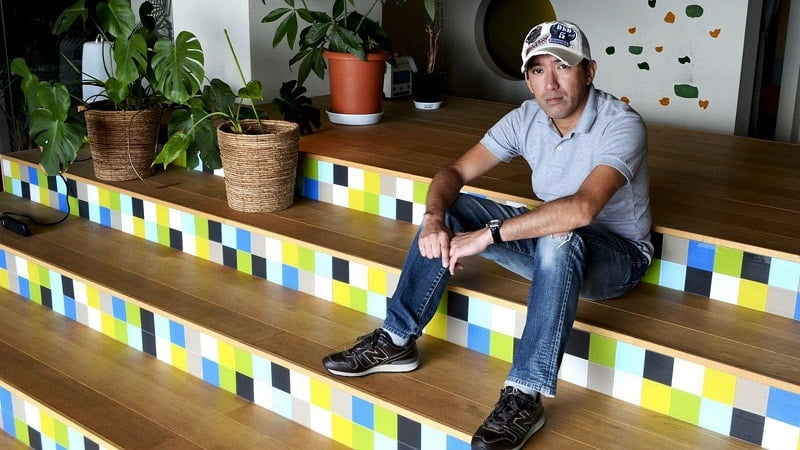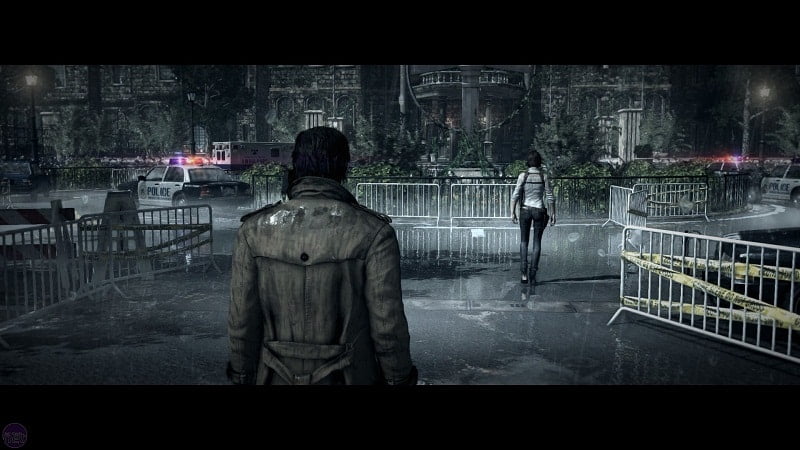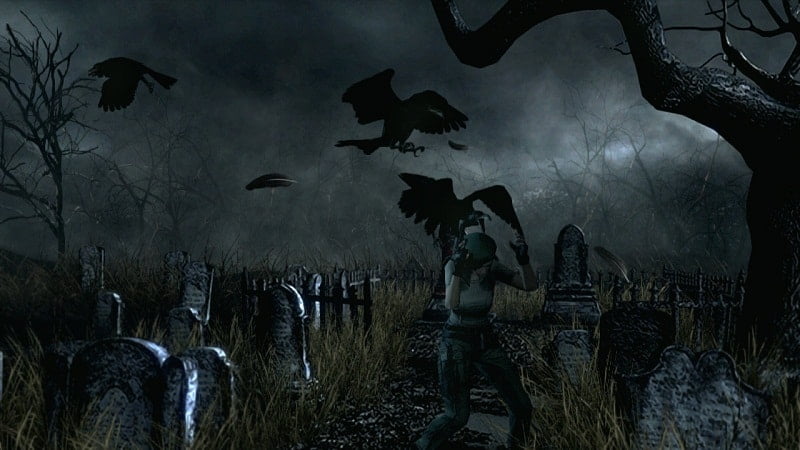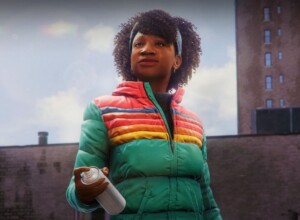Shinji Mikami makes soft, precise gestures with his hands when he talks. You’ll often find him peering out from underneath a sports cap, sometimes in a leather jacket. He’s fifty-two years old and he seems subdued. But you can see the energy and madness bubbling away beneath the restraint. In interviews he’s an odd figure; he has the same coltish presence as his characters.
He creates fear with astonishing economy. Take the beginning of The Evil Within: a detective is called to a mental hospital to investigate a murder. This simple set-up is touched by Mikami’s magic. The flashing police lights splash colour against the drab walls of the hospital; light rain makes the sodium bleed. Floors slick with blood, bodies strewn about the lobby, surreal figures stalking through long corridors: he works with assured speed, giving you nowhere to hide.
The opening is an art Mikami has perfected over the course of two decades. Whether it be throwing you into the fire (Resident Evil) or bringing slow tension to the boil (Dino Crisis), he knows which nerves to hit. But while you may still talk about the low-hanging mist, skeletal trees, and the distant howl of a chainsaw at the outset of Resident Evil 4, you probably won’t remember as fondly unloading the lion’s share of a machine-gun clip into an armour-clad zombie on a military base. This is because Mikami hasn’t perfected the close, and his focus wavers.
But while you may still talk about the low-hanging mist, skeletal trees, and the distant howl of a chainsaw at the outset of Resident Evil 4, you probably won’t remember as fondly unloading the lion’s share of a machine-gun clip into an armour-clad zombie on a military base. This is because Mikami hasn’t perfected the close, and his focus wavers.
He roves from idea to idea with the restless energy of a perfectionist constrained by craft. One of the problems The Evil Within had was the creak of its chassis: letterboxing limiting your awareness, sparse checkpoint saves, familiar scenes of villages, pitchforks, torches, and the awkward heft of a hero heaving his weight in jerks and spasms at odds with his environs.
There was the feeling of a cobbler sticking to his last about The Evil Within, of safe bets and diminishing returns. And though there’s nothing wrong with a director playing to his strengths, the game groaned with autumnal familiarity. But then, something wonderful: the ghostly notes of Clair de Lune hang on the night air. They lead you through cracked mirrors to the cold comfort of an asylum. Only Mikami.
He is a developer whose influence is most potently felt in flicks of the wrist and distinctive flourishes. His beginnings, his tone, his touch: these are best honed and shepherded by other directors.
And he is best served shepherding them.
Resident Evil 2 is considered by many to be the apogee of survival horror. Its baroque inner spaces broaden into an urban inferno; its horror shuffles off the clichéd confines of the spooky mansion and takes root in the streets – nowhere to hide, not even in modernity. It’s a whirlwind of pace and structure, character and plot. What was initially a hands-on role in the game’s development loosened as Mikami stepped back into the wings. He came to loggerheads with a young firebrand Hideki Kamiya. It was a brave decision to release his grip and allow Kamiya room to breathe, a decision steeped in trust, yes, but one bolstered with the power of final cut.
What was initially a hands-on role in the game’s development loosened as Mikami stepped back into the wings. He came to loggerheads with a young firebrand Hideki Kamiya. It was a brave decision to release his grip and allow Kamiya room to breathe, a decision steeped in trust, yes, but one bolstered with the power of final cut.
The story of Resident Evil 2‘s development has been interred in the crypt of gaming legend: at around 60-80% completion, Mikami pulled the plug on the project. What is now called Resident Evil 1.5 was an effort which Mikami scrutinised and praised; it was an effigy to be burnt in the fires of development. He trusted Kamiya to start over again.
Mikami’s relationship with Kamiya blossomed, at least professionally and creatively, at that moment. Given directing duties for Resident Evil 4, Kamiya set out to make a very different game indeed. A stylish action piece with a superhuman bounty hunter at its heart, this wasn’t a game about survival; it was about thrills and stylish triumph.
Mikami, rather than reject Kamiya’s attempt, again recognised its potential. He stepped out the wings into the director’s chair, and let Kamiya pursue this new idea on his own. Mikami understood what it was to be consumed with ideas. That game turned out to be Devil May Cry.
Kamiya went on to direct Viewtiful Joe, one of the Capcom Five – an array of games which Mikami produced for Nintendo’s GameCube. Alongside it was P.N. 03, Resident Evil 4, the subsequently cancelled Dead Phoenix, and Killer 7. The latter was co-written by Mikami and directed by Suda Goichi, effectively launching his career as an auteur. The game’s convulsive controls feel like a natural extension of Mikami’s approach: constricting movement and binding players to characters, exposing their vulnerabilities.
Mikami’s work as a director is that of a man haunted by ideas. Bound to them like a wraith, he returns to hallowed ground to perfect his art. Consider Resident Evil, his 2002 remake. It was the swan song of a particular tradition in survival horror, parade’s end.
Here was a work of love, a chance to burnish with exquisite power the rusted metal of an old mechanism; a chance to bring to aching life the poetry and truth of his vision, shackled as it was by the limited power of the PlayStation.
Mikami has always been in love with the night: the oily glisten of the moon caught in crow’s feathers, the silky wings of moths fluttering by gauzy lamplight, and the obbligato of his obsession, Beethoven’s Moonlight Sonata baying from the bowels of the mansion. The success of Vanquish, a slick, kinetic arcade shooter with balletic movement, is a second take on P.N. 03 – the black sheep of Mikami’s catalogue, and one where his penchant for constrained control struggled against a game demanding fluidity and grace.
The success of Vanquish, a slick, kinetic arcade shooter with balletic movement, is a second take on P.N. 03 – the black sheep of Mikami’s catalogue, and one where his penchant for constrained control struggled against a game demanding fluidity and grace.
Resident Evil 4, his greatest achievement, had ideas that wracked his mind long after its release. The earliest versions of the game had touches of distorted reality: porcelain dolls scuttling across floors, wall-mounted deer-heads writhing and twitching, and hook-armed spectres bursting from paintings, bathed in a lunar glow. Were these real or shades of madness?
Transfixed by these themes, he revisited them for The Evil Within, and there is a feeling of relief, of comfort, about the game. It feels as if it was made in a time capsule; here is the game that Resident Evil 5 wasn’t, the game to truly follow Mikami’s magnum opus. But it fell short, its potency eroded with formulaic design and old-school clunk.
John Johanas directed the two pieces of DLC for the game, The Assignment and The Consequence, and they both felt different. They felt like they had been directed not from within a time capsule but with their eyes and ears open. They were released in a world where Amnesia exists; they prised stealth, and evasion, championing the sort of vulnerability Mikami had established so long ago and strayed from. They weren’t survival horror; they were horror.
Johanas is directing The Evil Within 2, a game that will benefit from the stewardship and trust of Mikami as a producer. The latter’s skill as a director is one of restless innovation, but in the end, his power is a reflection of one of his most beautiful motifs: he is most potent not at the centre, not on the ground, but up high in distant orbit, guiding his creators like the light of the moon.






